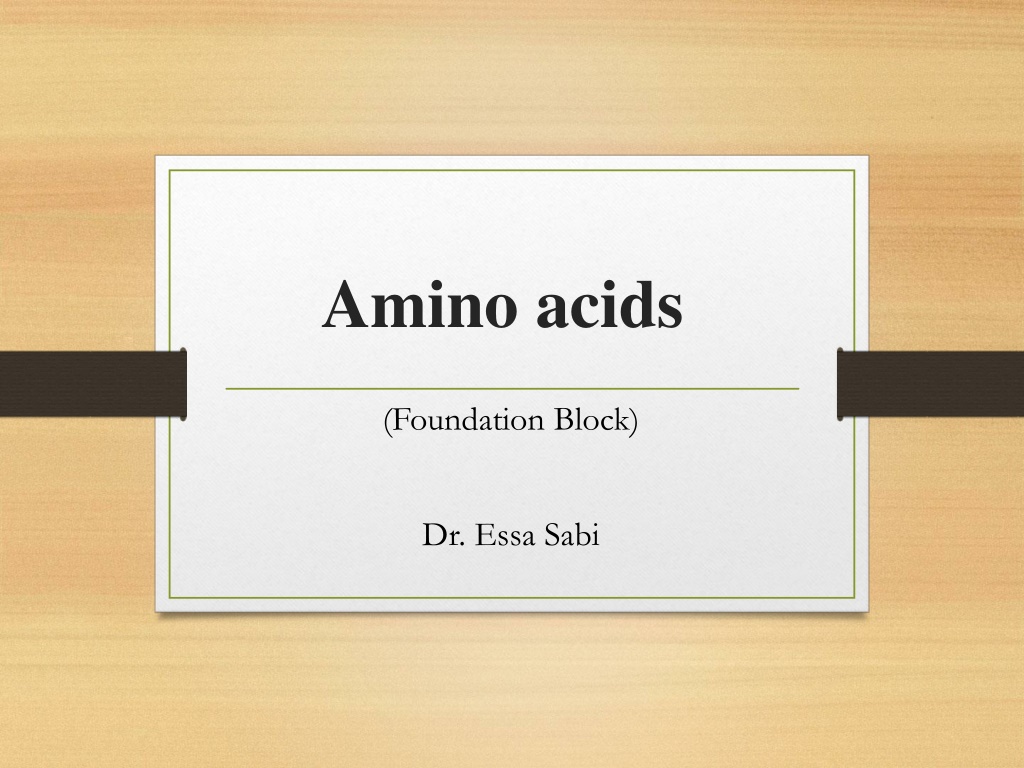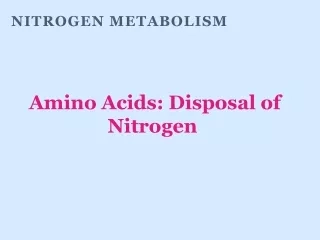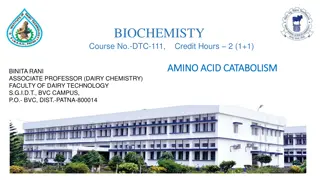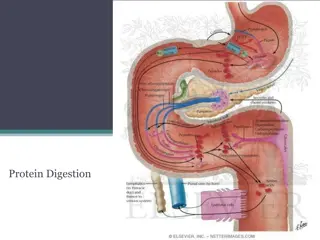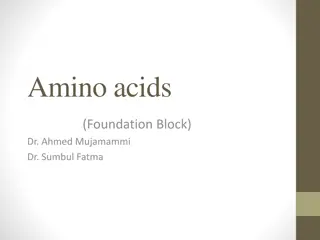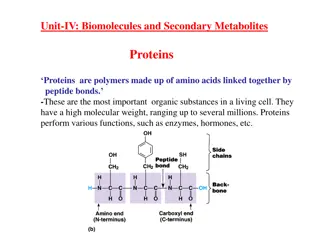Understanding Amino Acids: Structure, Classification, and Properties
Amino acids are crucial chemical units that form proteins and play essential roles in the body. They consist of a carboxyl group and an amino group, serving as building blocks and metabolic intermediates. This article covers the general structure, zwitterions, isoelectric point, pK values, and classification of amino acids based on body requirements. Essential, nonessential, and conditional amino acids are explained, along with grouping based on side chain properties. Discover the fundamental aspects of amino acids in this comprehensive guide.
Download Presentation

Please find below an Image/Link to download the presentation.
The content on the website is provided AS IS for your information and personal use only. It may not be sold, licensed, or shared on other websites without obtaining consent from the author. Download presentation by click this link. If you encounter any issues during the download, it is possible that the publisher has removed the file from their server.
E N D
Presentation Transcript
Amino acids (Foundation Block) Dr. Essa Sabi
Learning outcomes What are the amino acids? General structure. Classification of amino acids. Optical properties. Amino acid configuration. Non-standard amino acids. Derivatives of amino acids.
What are amino acids? Amino acids are the chemical units that combine to form proteins. Amino acids are a type of organic acid that contain both a carboxyl group (COOH) and an amino group (NH2). Amino acids play central roles: as building blocks of proteins and as intermediates in metabolism. Humans can produce about half of amino acids. The others must be supplied in the food. When proteins are digested or broken down, amino acids are left.
Zwitterion Net charge is zero on the molecule
Isoelectric point The pH at which the molecule carries no net charge. In acidic solution-cationic. In alkaline solution- anionic.
pK Value It is the ability of an acid to donate a proton (dissociate). Also known as pKa or acid dissociation constant. The pK values of -carboxylic group is in the range of 2.2. The pK values of -amino group is in the range of 9.4.
Titration curve of glycine pK1- pH at which 50% of molecules are in cation form and 50% are in zwitterion form. pK2- pH at which 50% of molecules are in anion form and 50% are in zwitterion form. Buffering action is maximum around pK values and minimum at pI.
Classification of amino acids Based on the body requirement, amino acids can be classified into three groups: Essential amino acids: cannot be made by the body. e.g. histidine, isoleucine, leucine, lysine, methionine, phenylalanine, threonine, tryptophan, and valine. Nonessential amino acids: produced by the body. e.g. alanine, asparagine, aspartic acid, and glutamic acid. Conditional amino acids: not essential, except in time of illness or stress. e.g. arginine, cysteine, glutamine, tyrosine, glycine, proline, and serine.
Continued According to the properties of the side chains, amino acids can also be grouped into three categories: Nonpolar amino acids. Uncharged amino acids. Polar amino acids.
Nonpolar amino acids Each amino acid does not bind or give off protons or participate in hydrogen or ionic bonds. These amino acids promote hydrophobic interactions. In proteins found in aqueous solution, the side chains of the nonpolar amino acids tend to cluster together in the interior of the protein. The nonpolar R-group fill up the interior of the folded protein and help give it its 3D shape. In proteins located in hydrophobic environment, such as a membrane, the nonpolar R-groups are found on the outside surface of the protein, interacting with lipid environment to stabilize protein structure.
Continued The structure of the proline amino acid differs from other nonpolar amino acids that the side chain of proline and its - amino group form a ring structure (an imino group).
Continued These amino acids have zero net charge at neutral pH. However The side chains of cysteine and tyrosine can lose a proton at an alkaline pH. Serine, Therionine and Tyrosine each contain a polar hydroxyl group that can participate in hydrogen bond formation. The side chains of asparagine and glutamine each contain a carbonyl group and an amide group, both of which can also participate in hydrogen bonds.
Polar amino acids Amino acids with acidic side chains: Aspartic and glutamic acids are proton donors. At neutral pH, these amino acids are fully ionized (negatively charged). So, they are called aspartate and glutamate.
Continued Amino acids with basic side chains: Histidine, Lysine and Arginine are proton acceptors. At neutral pH, lysine and arginine are fully ionized (positively charged).
Optical properties The -carbon of most of the amino acids is attached to four different chemical groups. Thus, asymmetric molecules are optically active, and symmetric molecules are optically inactive. All mammalian amino acids are optically active except glycine. They rotate the plane of polarized light in a polarimeter.
Continued L-Amino acids rotate polarized light to the left. D-Amino acids rotate polarized light to the right. Both L and D forms are chemically same. All mammalian amino acids are found in L-configuration. D-amino acids are found in antibiotics, plants and in the cell wall of microorganisms.
Amino acids derivatives Gamma amino butyric acid (GABA, a derivative of glutamic acid) and dopamine (from tyrosine) are neurotransmitters. Histamine (Histidine) is the mediator of allergic reactions. Thyroxine (Tyrosine) is an important thyroid hormone.
Take home messages Each amino acid has an ?-carboxyl and a primary ?-amino group (except for proline, which is an imino acid). At physiological pH., the ?-carboxyl is dissociated. Each amino acid also contains twenty distinctive side chains and the chemical nature of this side chain determines the function of the amino acid. All free amino acids and charged amino acids in peptide chains, can serve as buffers.
Take home messages Buffering action of proteins is maximum around pK values and minimum at isoelectric point. All mammalian amino acids are optically active except glycine. All mammalian amino acids are found in L-configuration
References Lippincott s Illustrated reviews: Biochemistry 4th edition, Unit 1, Chapter 1, Pages 1-12.
